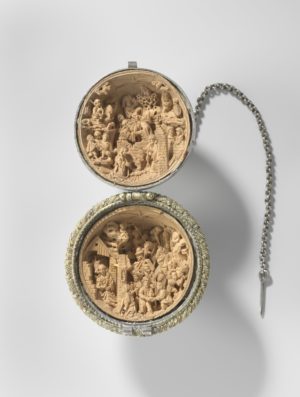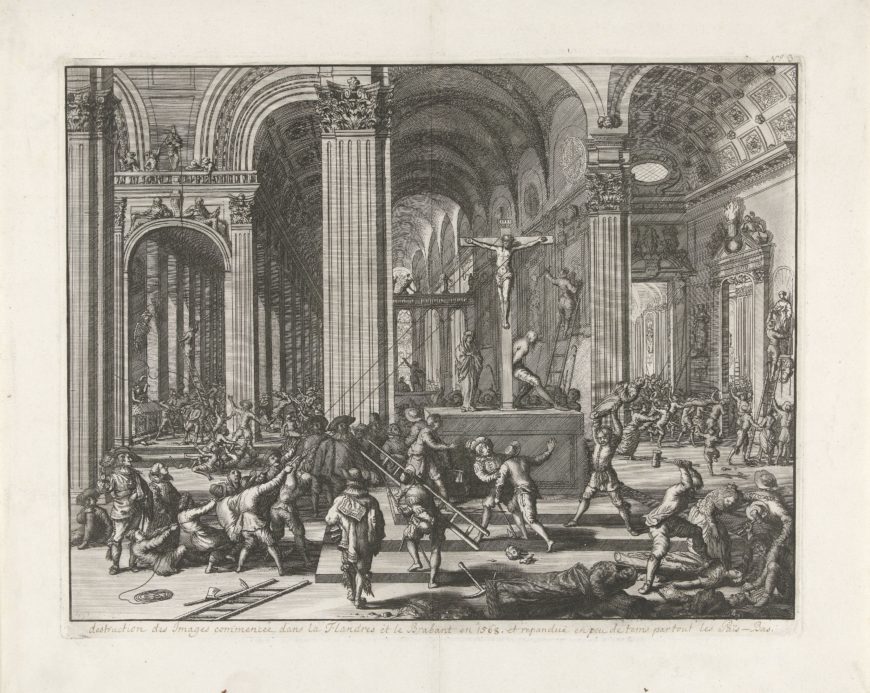Iconoclasm in the Netherlands in the Sixteenth Century
Breaking idols
The word “iconoclasm” refers to any deliberate destruction of images.

Here, iconoclasm specifically refers to the events of 1566 in an area that we now know as Belgium and the Netherlands. Prior to 1566, most churches in this region would have been largely encrusted with ornament: guilds commissioned altarpieces for their chapels while private patrons donated memorial paintings, endowed tomb sites, and donated elaborate shrines or ritual vessels. Piety was made visible in the material culture of the church, paralleling a northern European explosion in personal devotional artwork in the form of manuscripts, woodcut prints, carved boxwood shrines and prayer beads, and small paintings.
Protestant change
The northern humanist Desiderius Erasmus noted that the physical veneration of an object made it an active agent and turned it into an idol, pushing the objects and images traditionally at the heart of northern European piety into the zone of the idolatrous. Therefore, to use an image as part of your prayers creates idols — the very sin explicitly condemned in the Second Commandment, which reads: “You shall have no other gods before me. You shall not make for yourself a graven image.” (Exodus 20:3)
Luther himself was not entirely anti-image, stating that if there was no sin in the heart, there was no risk in seeing images with your eyes. However, the faithful needed to remove the roots of sin in themselves; they needed to worship God and not a material object which takes the place of God. Luther later clarified that what the second commandment prohibited was images of God; images of saints or crucifixes were not condemned by him as they serve as memorials.
Iconoclastic riots
The hedge preachers (wandering figures who whipped up anti-Spanish and anti-Catholic sentiment in sermons held outdoors, and usually outside of city walls and therefore beyond easy jurisdiction) were at least partially responsible for the ignition of the Beeldenstorm, the sudden outbreak of violence against religious images that began in the summer of 1566 and spread throughout the Low Countries. In response to their anti-Catholic preaching, violence began in West Flanders and radiated outward.
In some towns, it was outright mob violence: groups of people burst into churches, smashing windows and sculptures. In other cities, the destruction of religious images was systematic and either openly or covertly supported by the local government. In some cases, the iconoclasts and the local Catholic Church officials negotiated for the survival of certain artworks.
To destroy the objects and ritually humiliate them was to reject the broader political and religious structures they represented, as well. Sculptures were torn down from their niches, windows were smashed, and altars and shrines were disassembled and burned.
When the sculptures were part of the fabric of the building and could not be easily removed, the heads of the figures were hacked off. Examples reflecting this kind of violence remain visible in churches throughout the Northern Low Countries inside previously Catholic, now Protestant churches.

Iconoclasm in 1566 was not just the result of doctrinal disagreement about the nature of religious imagery and the interpretation of biblical text. It was instead a response to intertwined issues of politics, religious oppression, and economic factors. It was one spark that helped ignite the flames of the Eighty Years War, a war that ultimately resulted in the split between the northern Calvinist provinces of the Dutch Republic and the southern Catholic province that remained connected to Spain. As much as the violence of the Beeldenstorm itself may have been short-lived, the broader cultural and historical changes that cascaded as a result had permanent and far-reaching consequences.[1]
- Dr. Saskia Beranek, "Iconoclasm in the Netherlands in the Sixteenth Century," in Smarthistory, July 2, 2015, accessed March 31, 2023, https://smarthistory.org/iconoclasm-netherlands/ ↵

